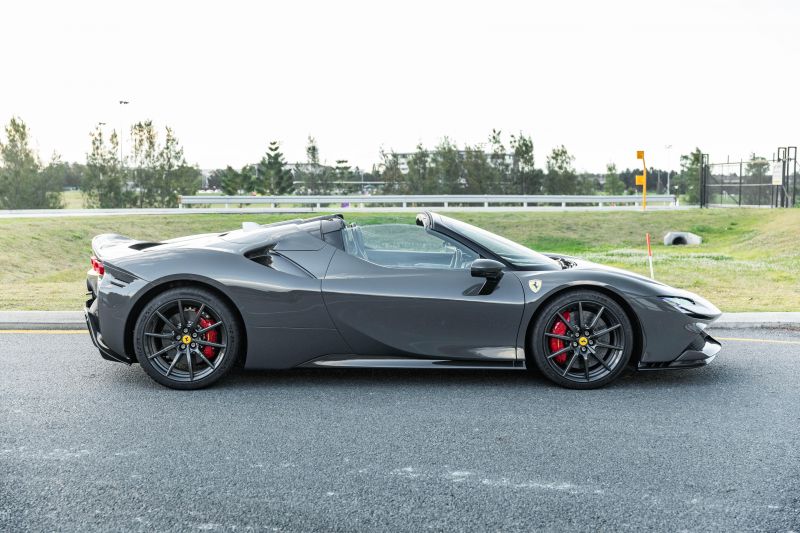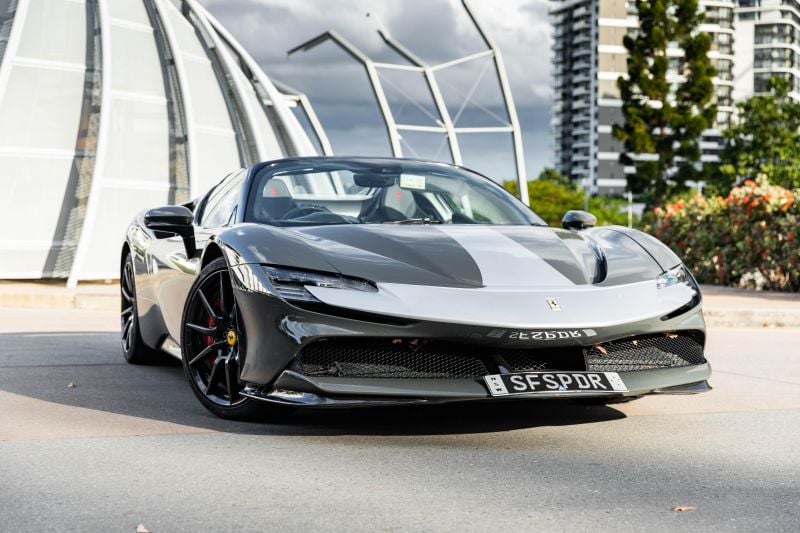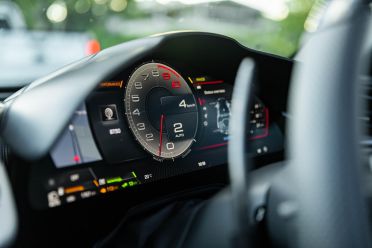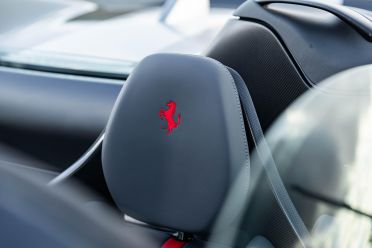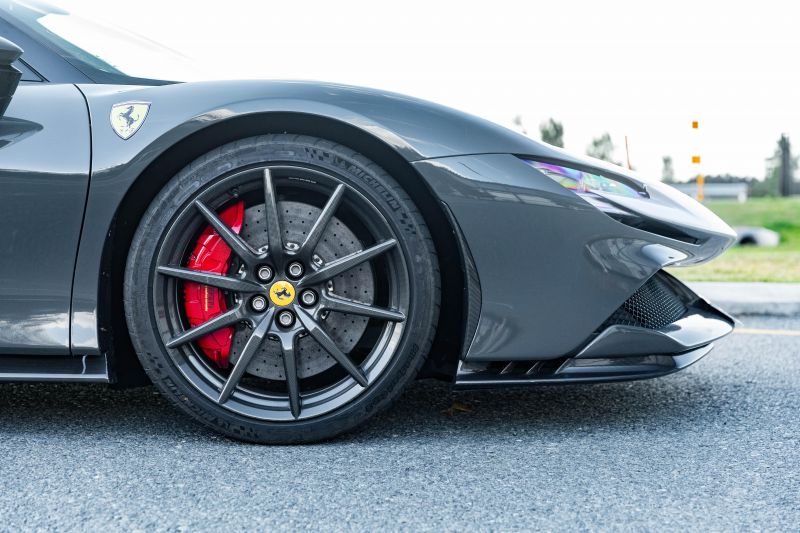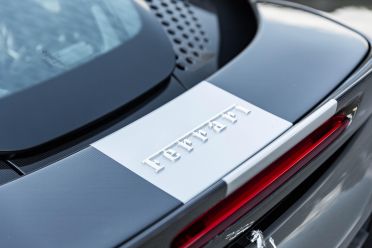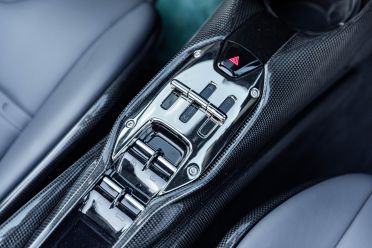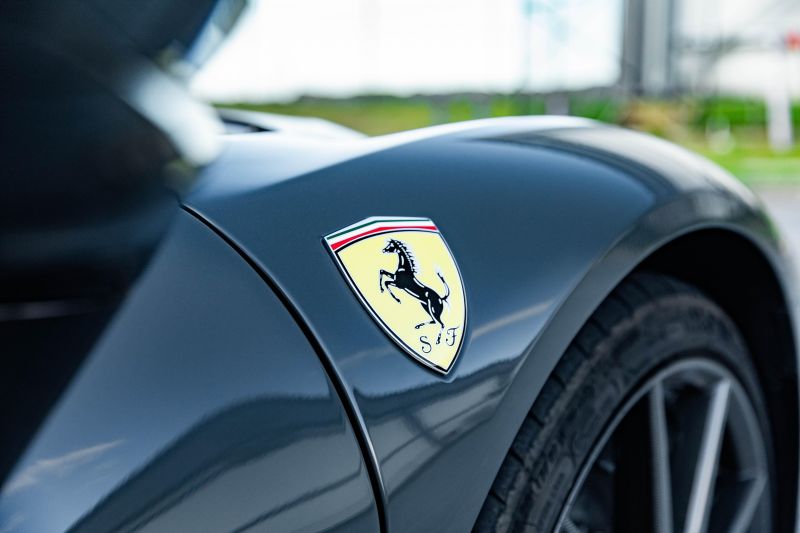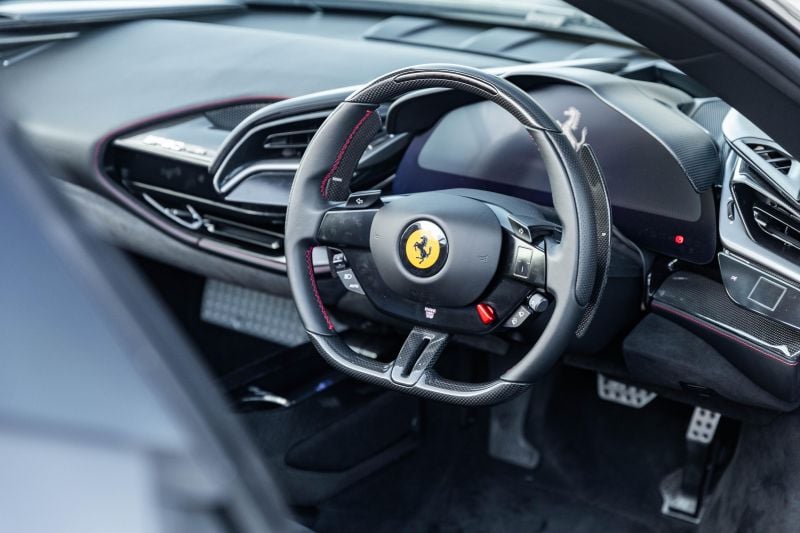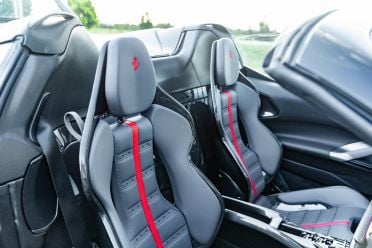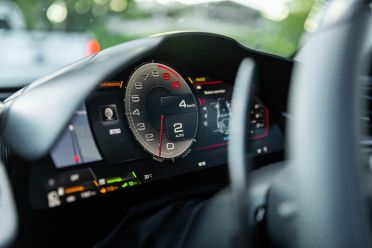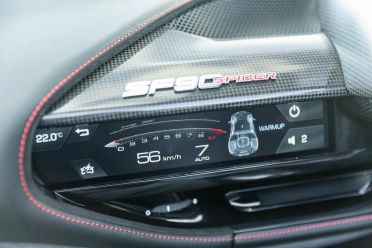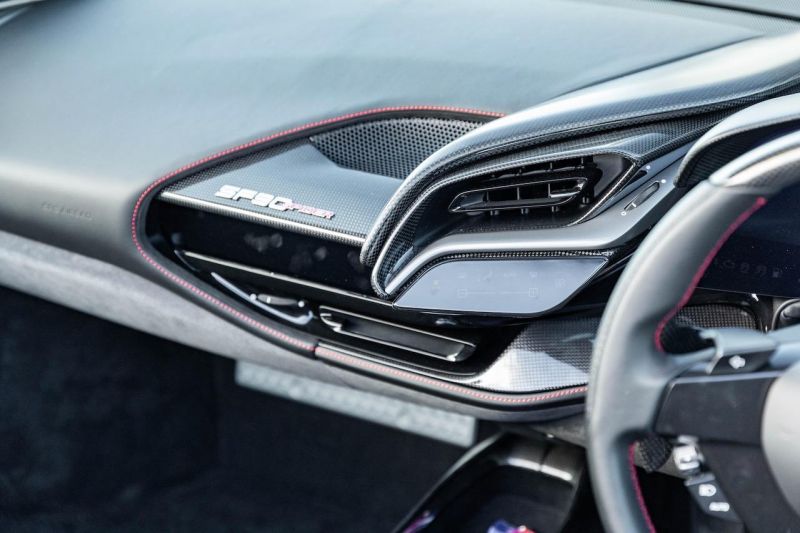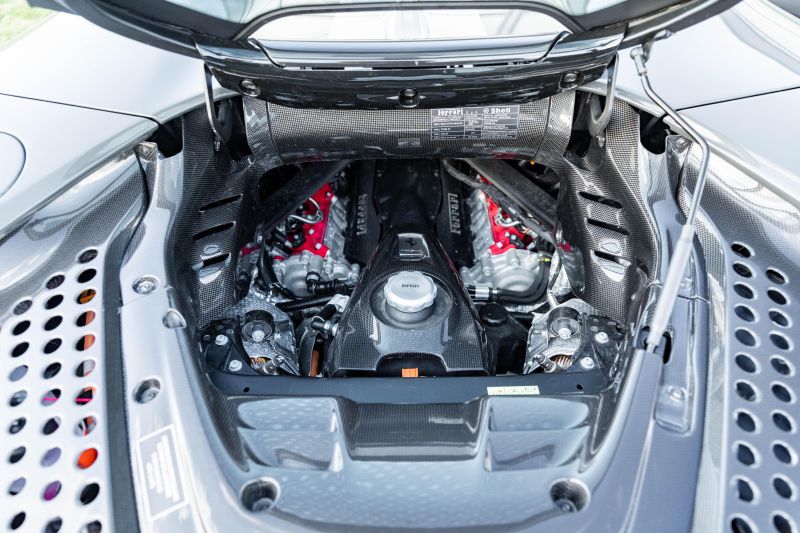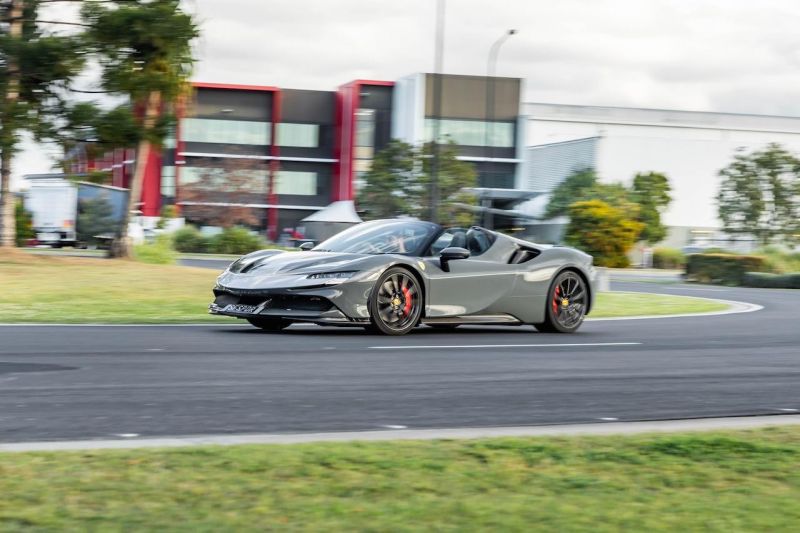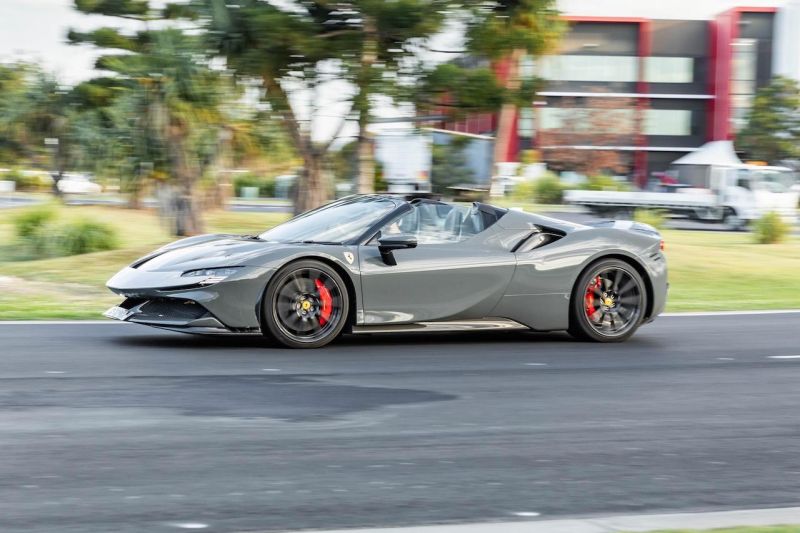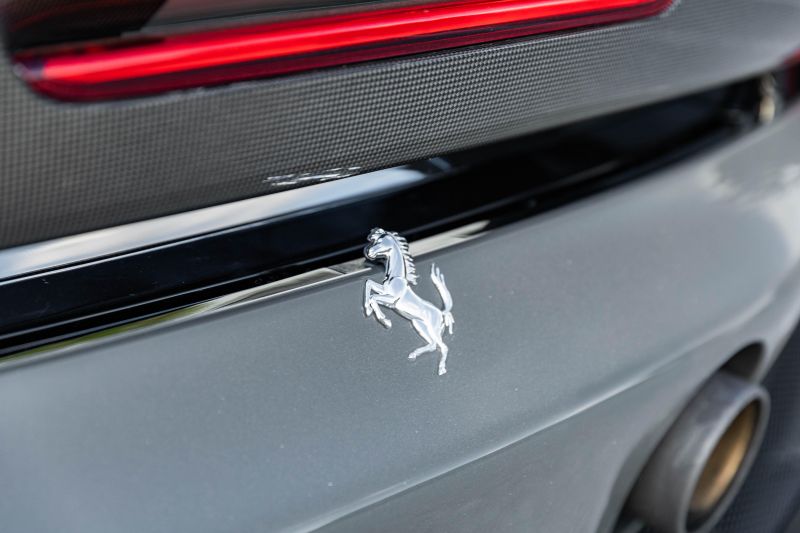I’m not up with all the current NBA players who reside in the more salubrious burbs in Los Angeles, but on a recent trip to the City of Angels I saw my first privately owned Ferrari SF90 Spider parked in an open garage in Bel-Air, and the guy standing next to it looked a lot like LeBron James.
Makes sense, too, given James is said to be a passionate car collector, boasting a stable counting more than a few high-end Ferraris and more than willing to spend the equivalent of around AU$1.4 million a pop, at least here in Australia.
However, calculating the real drive-away price of a Ferrari at this level, given the degree of personalisation associated with cars in this price range, is always tricky. Nevertheless, this a car that would likely take pride of place in anyone’s garage, no matter how big a bank balance they might have or how big a celebrity they might be.
That’s because the SF90 Spider is simply like no other road-going Ferrari to come before it. It’s the Prancing Horse’s first production plug-in hybrid drop-top, and the numbers (apart from its stratospheric price tag) are simply astonishing.
Powered by a mid-mounted 4.0-litre twin-turbocharged V8 with a flat-plane crank and three electric motors, the SF90 Spider is able to unleash a combined output of 1000cv (735kW of power) at 7500rpm and 800Nm of torque from 6000rpm. And just for the record, this particular engine produces more power than any other V8 turbo ever built by Ferrari – surely that’s a claim worth bragging about.
What’s more, there’s proper Ferrari Formula 1 tech at play here given the electric motor at the rear of the car is called the MGUK (Motor Generator Unit, Kinetic), taken directly from its F1 team innovation.
It’s not just the crazy power outputs that can set off an adrenalin rush, it’s also the SF90 Spider’s well-substantiated performance claims that can require a recalibration of all the usual senses. It’ll go from standstill to 100km/h in 2.5 seconds and 0-200km/h in 7.0 seconds flat. Top speed is listed as 340km/h – though a colleague who’s driven the car in Germany says it’s definitely faster.
That shouldn’t come as much of a surprise either, because of all the production series Ferraris from the last few decades, the SF90 Spider holds the second-fastest lap time around Ferrari’s famed Fiorano test track. It only lost out to its hardtop SF90 Stradale sibling – 1m 19.5s compared to 1m 19s. There’s nothing in it, really.
It’s also faster than the celebrated LaFerrari with its V12 hybrid power unit, which not only makes it the most powerful but also the fastest series production Ferrari ever built. I’d also argue it’s the most technically-advanced series production car ever to come out of the factory gates in Maranello, and one that realises the direct transfer of the brand’s Formula 1 technology to a street-legal road car.
Despite the unavoidable issues associated with aero and the additional 100 kilograms as a result of the retractable hardtop roof over the Stradale, the SF90 Spider’s complex engineering solutions pretty much avoid any nasty side effects in terms of outright performance between the two Prancing Horse siblings. There’s very little in it.
The roof itself is a sublime bit of engineering, though effectively an evolution of that used in the 458 Spider from 2011. It’s a compact unit with a largely aluminium construction weighing around 40kg less than a conventional retractable hardtop and taking up minimal space at the same time. That’s also with an electrically-adjustable rear window, for more or less noise, at the flick of a switch.
It’s hard not to get caught up in the SF90’s meticulous attention to detail – the last thing I want to do is bore you – but the gearbox alone is a wonderful example of the kind of cutting-edge engineering that’s gone into this car.
First off, it’s an eight-speed oil-bathed dual-clutch transmission using a dry sump that’s somehow 20 per cent smaller than Ferrari’s seven-speed unit, while being mounted 15 per cent lower in the car. It can also transmit up to 900Nm of torque (20 per cent more than the seven-speed ‘box) and weighs 10kg less, while able to swap gear ratios in just 200ms, or 30 per cent faster than the seven-speed DCT.
Ferrari left no stone unturned in the development of its ultimate Spider build, because no matter where you look, from the exhaust to aerodynamics, the engineering in this Ferrari boarders on the obsessive. It’s something you can feel right from the very moment you climb aboard and tap the digital starter button, which immediately readies the car for full EV drive.
There’s a genuine sense you’re in control of something mighty, albeit worlds away from any Ferrari you might have known previously. It’s all a bit surreal to be honest as there’s just so much to take in – and we only had five hours behind the wheel. No complaints, though.
How much does the Ferrari SF90 Spider Assetto Fiorano cost?
In stock-standard form the Ferrari SF90 Spider has a price tag of $929,888 plus on-roads, or $83,000 more than the SF90 Stradale (Coupe).
But, when you add the more focussed Assetto Fiorano Package, the price jumps another $111,000 to $1,040,000 before on-road costs.
From there we count another 35 tasty options including the Grigio Scuro paint job and Australian-made carbon-fibre wheels, which send the price skyrocketing to an eye-popping $1.4 million.
This is enough to induce a slight heart flutter right before the Ferrari guy hands you the key fob and sends you on your way.
What do you get?
Listing standard equipment is all a bit pointless in this car, mainly because the actual features inventory the car is equipped with is disappointingly minimal due to the level of customisation common at this level of car ownership.
In fact, the list of standard equipment will surely be laughable to anyone driving a sub $70,000 SUV these days, given how well these vehicles are specified, whereas the Ferrari comes with:
- Matrix LED headlights w/ LED turn signals and side lights
- 20-inch die-cast wheels
- Magnaride adaptive suspension system
- Carbon ceramic brake system
- Front bonnet in painted carbon
- Front and rear bumpers in painted carbon-fibre
- Car protection cover
- Keyless entry and start
- DAB Digital Radio
- Bluetooth streaming
- Dual-zone air conditioning
And that’s the extent of standard features on this highly-prized Ferrari – everything else down to Apple CarPlay and rear parking camera are optional extras on the SF90 Spider.
So, here goes:
- Exterior paint colour – Grigio Scuro
- Interior colour – Charcoal
- Carpets – Extracampionario
- Two-tone Stripe
- Two-tone body painting – Nero DS
- Carbon-fibre wheels – glossy
- Red brake calipers
- Titanium wheel bolts
- Carbon-fibre front bumper insert
- Carbon-fibre underdoor cover
- Carbon-fibre side air splitter
- Carbon-fibre rear diffuser
- Carbon-fibre rear boot trim
- Carbon-fibre engine covers
- Carbon-fibre engine manifold
- Rear parking camera
- Scuderia Ferrari shields
- Black ceramic exhaust pipes
- Anti-stone-chipping film
- Electrochromatic exterior mirrors
- Rosso-coloured stitching
- Cavallino stitched on headrest
- Rosso Ferrari-coloured leather seat stripes
- Daytona racing seats
- Coloured mats with logo
- Mats in leather/Alcantara
- Fiorano Package
- Extended Fiorano Package
- Apple CarPlay
- Dashboard stripe inserts in carbon fibre
- Carbon-fibre upper tunnel trim
- Carbon-fibre trunk covers
- Carbon-fibre rear shelf
- Carbon-fibre driver zones with LEDs
The Assetto Fiorano Package turns the already-manic SF90 Spider in to a more focussed machine by adding exclusive upgrades, including fixed-rate shock absorbers developed for Ferrari’s GT racing program by Multimatic.
Then there’s a titanium exhaust system, as well as more carbon-fibre and lightweight metal that shaves a further 21kg off the car’s weight, which we calculated to be around 1640kg (dry) or 1750kg with consumables and driver.
There’s also a carbon-fibre rear spoiler and road-homologated Michelin Cup 2 tyres constructed with a softer compound for better grip on a dry track – almost semi-slicks if you will.
Is the Ferrari SF90 Spider Assetto Fiorano safe?
Apart from the 4WD hybrid drive mode (one of three power delivery modes) designed to give you maximum traction out of corners, plus energy recovery using lift/off braking, the SF90 Spider gets:
- Front airbags for driver and passenger
- Side airbags for driver and passenger in door panels
- Tyre pressure and temperature monitoring system
It’s also worth noting the SF90 uses 50 per cent more rivet-bonded connectors than used in the Ferrari F8 Tributo, to produce a body shell that’s 40 per cent stiffer in torsion and 30 per cent stiffer in bending than the F8, making it the stiffest (regular) production series Ferrari to date.
As well, the crossbeam and the bulkhead are constructed from carbon-fibre, another first for a production Ferrari.
That said, like almost all high-end supercars, including the more humble Porsche 911, none are crash-tested and are therefore without Euro NCAP or ANCAP safety ratings.
What is the Ferrari SF90 Spider Assetto Fiorano like on the inside?
Whenever you climb into a Ferrari (any Ferrari) there’s always a sense of occasion about it, and for me, it’s been that way ever since I slid into a mint-condition Dino 246 GTS in Rosso Chiaro with Tan leather (Black was more common) back in the mid-eighties, and was totally besotted by everything from its glorious lines to the gated shifter.
Hopping in to the SF90 Spider is no less of an occasion but it couldn’t be more different to the Dino. It shows just how much Ferrari has evolved with the use of cutting-edge technology designed to enhance the driving experience.
Traditionalists may not think that way, and I get that, because you only have to look around at the astronomical prices that are being paid for classic Ferraris with manual transmissions. And besides, who doesn’t want to drive a manual Ferrari like a Dino or 328 GTS.
But times have changed, and the SF90 Spider represents the pinnacle of Ferrari’s series production road cars. The very latest in electronic wizardry features heavily in the cockpit: a direct result of Ferraris Formula 1 program, at least that’s the sense I get.
Take the steering wheel. It’s a masterpiece of design that artfully blends uncluttered simplicity with complex electronics and prefect ergonomics in line with Ferrari’s mantra of ‘eyes on the road, hands on the wheel’. For the most part it works a treat, once you get your head around all the various functions you have fingertip access to, which is pretty much everything.
When the ignition is off all the screens (steering wheel and massive digital instrument display) are inert and completely black. It looks like there’s nothing going on, but the moment you hit the touch-like starter button, it all comes to life in a blaze of colour and a multitude of digital displays on offer.
At first sight, it’s all a bit daunting and remember, this is just a road-going sports car. It’s also at this very moment you get some idea of how incredibly difficult it must be for F1 drivers travelling at up to 320km/h through a turn, while adjusting the likes of brake bias or any other critical performance-enhancing mode on the steering wheel.
The central instrument cluster comprises a huge 16-inch curved screen that wraps around the driver’s position and displays Ferrari’s familiar tachometer in the centre while flanked by two smaller screens; the left-hand side for infotainment and the right side for technical information including drive and power modes.
All of this is controlled via a trackpad on the right and various touch buttons on both sides. There’s a lot going on but oddly enough it doesn’t take that long to get to the gist of things, even though there are two further control units; one for the side mirrors, the other for the air-con.
There’s also a second screen for the passenger that displays speed, gear position and rpm – handy if you want to catch a pic of a big number on the Autobahn for bragging rights, I guess.
Last but not least is the F1-style Manettino switch that allows the driver to easily switch between the various drive modes: eDrive (purely battery power for driving up to 25km and a 135km/h limit); Hybrid (optimised performance from both the ICE and electric motors working in concert); Performance (keeps the ICE running 100 per cent of the time for best response); Qualify (allows maximum power output from electric motors – 162kW with minimal regen).
The glossy carbon seat shells that make up the Daytona Racing Seats in our tester are visually exquisite, boasting minimal leather inserts but somehow perfectly supportive and comfortable at the same time. They are not the easiest seats to climb out of, however.
There’s no centre console box as such, but there’s several spaces for the likes of phones and wallets forward and aft of Ferrari’s cool modern take on the shift gates of what are now its classic models.
The entire floor and sides of the footwell are covered in swathes of Alcantara, which is also used for the floor mats. If you’re looking for space for small bags you’ll find such a depository in the frunk, but be warned it’s tiny.
What’s under the bonnet?
As Ferrari’s first production plug-in hybrid drop-top, the SF90 Spider pairs a newly-developed 4.0-litre twin-turbo V8 with three electric motors.
Two of the motors are up front, and one F1-style MGUK (Motor Generator Unit Kinetic) is at the rear between the engine and the eight-speed dual-clutch auto gearbox (you can’t get a manual).
By providing electric motors on both axles, it gives the SF90 Spider AWD capability and the extra grip and traction that comes with that set up. Working in sync, the two power units produce a stratospheric 1000cv (735kW) of power at 7500rpm and 800Nm of torque at 6000rpm. That’s 60cv (44kW) more than any other V8 turbo ever built by Ferrari.
And, if you’re worried that the hybrid system might somehow dull the senses with a lack of good ole fashion noise, Ferrari’s acoustic maestros have built a special ‘hot tube system’ which pipes the ICE sound directly into the cockpit. You won’t be disappointed.
How does the Ferrari SF90 Spider Assetto Fiorano drive?
Ferraris have always been about noise – producing the ultimate ICE concerto anywhere from around 7000rpm. With the SF90 and its triple-motor hybrid system, however, you tend to start out in Hybrid mode, just for the novelty aspect of a completely silent super sports car from the Prancing Horse stable.
But like all novelties, it doesn’t last long before you start to squeeze on the throttle and experience what is nothing less than pure engineering sorcery – an utterly seamless transition from full EV power to the combined assault of Ferrari’s most powerful twin-turbo V8 and all three electric motors working in perfect synchronisation.
There’s no lag, not even a millisecond. I’ve never experienced anything quite like it. Then, when you start to focus on the sheer thrust this car is able to unleash with a more determined shove of the right foot – you’ll suddenly realise (for a few seconds at least) what 1000hp feels like.
It’s not like the first time you launch a Bugatti Veyron, which was just brute force – epic nonetheless). The SF90 Spider is different – nowhere near as scary, but just as ballistic.
There’s something about that bright red F1-style Manettino switch, too. I kept flicking between Hybrid and Performance, but mostly the latter for the noise factor alone – even if my top speed over the next few hours will likely be under 100km/h.
Accelerating in first and second gears at least allows some semblance of what is still a thoroughly intoxicating thrill from behind the wheel, even if it’s only at 6000rpm.
This is partially thanks to Ferrari’s aforementioned ‘hot tube system’, which pipes in ‘real’ engine noise to a point right behind the driver via tubes that run from the exhaust system and air intake. It is quite brilliant, especially in the open-top SF90 Spider.
I don’t believe there’s a more refined dual-clutch transmission than the eight-speed ‘box in the SF90. There’s zero vibration no matter how mechanically unsympathetic you are with the carbon-fibre paddle shifters, and it shifts are fast regardless of the speed.
In fact, in Performance mode, you won’t need to use the paddles, because even in ‘Auto’ if you’re coming into a corner hot under a hard brake, it will drop three gears with cracking downshift throttle blips quicker than you can pull the paddle.
Perhaps one of the most surprising aspects of driving the SF90 Spider is the fact it tips the scales at well over 1700kg (1640kg dry), yet it handles more like a car weighing less than 1600kg.
It feels cat-like when it comes to rapid directional changes and requires minimal steering input. There is a magnificent chassis at play here capable of insane levels of load – way more than I could ever muster.
Common with all Ferrari’s is the lightweight steering feel – even at high speeds. Mind, it’s weights up in the more aggressive drive modes and you tend to get used to it fairly quickly in concert with the quick steering.
Mostly, the SF90 Spider copes with the usual road conditions in Sydney, except for the really rough stuff. This is despite its fixed-rate titanium springs from Multimatic (as part of this car’s Assetto Fiorano pack). The ‘standard’ SF90 gets the more forgiving magnetorheological adaptive dampers that change depending on the driving mode selected, which would be the more preferred option anywhere but on the track.
Standard kit on the SF90 Spider are huge carbon-ceramic brakes (392mm front, 360mm rear), so you can imagine the kind of stopping power on offer here, but again there’s a natural feel and progression to the brake pedal, to the point they feel like steel rotors.
Naturally, we didn’t have the chance to exploit the Ferrari’s massive downforce potential (390kg in cornering at 250km/h) with the Assetto Fiorano pack fitted to our tester. Think about that for a minute and you’ll wish you were on a German Autobahn where this kind of advanced engineering could really be put to the test.
In the end, though, you’re entirely grateful even for a taste of driving such a monster-powered Ferrari that seamlessly blends an internal-combustion engine with electric motors in a way that still stirs the soul both from an acoustic sense and offers break-neck performance to rival the very best super sports cars.
How much does the Ferrari SF90 Spider Assetto Fiorano cost to run?
Ferrari offers a three-year, unlimited-kilometre warranty on the SF90 Spider, along with a maintenance program which covers all scheduled servicing for the first seven years of the car’s life.
Those service intervals are recommended at either 20,000km or once a year, whichever comes first.
CarExpert’s Take on the Ferrari SF90 Spider Assetto Fiorano
In an age where cars from bespoke manufacturers like Bugatti, Lamborghini, Pagani, Aston Martin, McLaren and even Gordon Murray Automotive are building cars which cost several million dollars or more, it could be argued that Ferrari’s SF90 Spider Assetto Fiorano might seem like something of a bargain.
Certainly, they’re no faster than the Ferrari and are generally far more intimidating for the driver. For the most part it’s the seamless nature of the Ferrari’s hybrid powertrain as it marvellously switches between electric and hybrid propulsion that’s sure to impress you most.
In the end it’s a triumph of a complex number of engineering solutions which interlace so seamlessly that make the SF90 Spider seem all so easy to pilot in any given situation.
The SF90 is an engineering masterpiece that keeps Ferrari relevant for these changing times we live in.
Click the images for the full gallery
MORE: Everything Ferrari SF90





